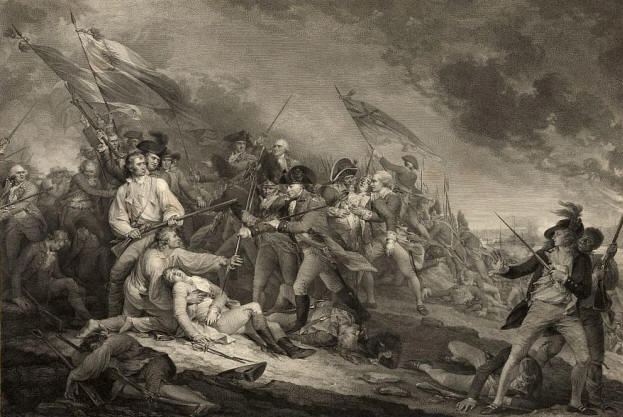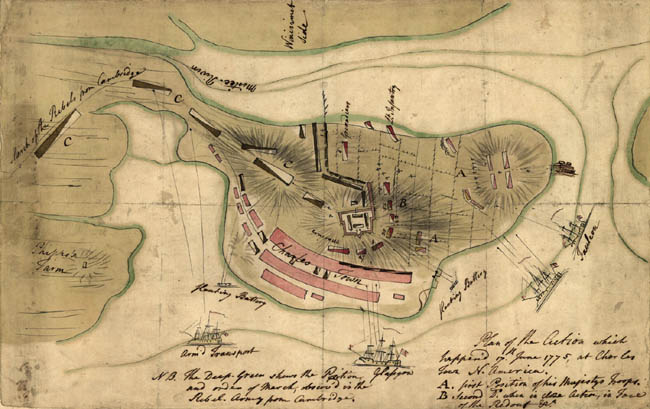Battle of Bunker Hill
|
|
This Site:
|
Bunker Hill, BATTLE OF. By reinforcements from England and Ireland, General Gage's army in Boston, at the end of May, 1775, was 10,000 strong. With the reinforcements came Generals William Howe, Sir Henry Clinton, and John Burgoyne, three officers experienced in the military tactics of Europe, but not prepared for service in America. Gage issued a proclamation (June 12) of martial law, and offering pardon to all who should return to their allegiance, except Samuel Adams and John Hancock. At that time the New England army around Boston numbered about 16,000 men, divided into thirty-six regiments, of which Massachusetts furnished twenty-seven, and the other three New England colonies three each. John Whitcomb, a colonel in the French and Indian War, and Joseph Warren, president of the Provincial Congress, were appointed (June 15) major-generals of the Massachusetts forces. These provincial troops completely blockaded Boston on the land side, and effectively held the British troops as prisoners on the peninsula. General Artemas Ward, the military head of Massachusetts, was regarded, by common consent, as the commander-in-chief of this New England army. The Americans had thrown up only a few breastworks - a small redoubt at Roxbury, and some breastworks at the foot of Prospect Hill, in Cambridge. The right wing of the besieging army, under General John Thomas, was at Roxbury, consisting of 4,000 Massachusetts troops, four artillery companies, a few field-pieces, and some heavy cannon. The Rhode Island forces were at Jamaica Plain, under General Greene, with a regiment of Connecticut troops under General Spencer. General Ward commanded the left wing at Cambridge. The Connecticut and New Hampshire troops were in the vicinity. Map of the Battle of Bunker HillIt was made known to the committee of safety that General Gage had fixed upon the night of the 18th of June to sally out and take possession of and fortify Bunker Hill (an elevation not far from Charlestown); also Dorchester Heights, south of Boston. Both of these points would command the town. The eager provincials determined to anticipate this movement, and the Massachusetts committee of safety ordered Colonel William Prescott to march, on the evening of the 16th, with 1,000 men, including a company of artillery, with two field-pieces, to take possession of and fortify Bunker Hill. This force, after a prayer by President Langdon, of Harvard, passed over Charlestown Neck; but, going by Bunker Hill, they ascended Breed's Hill (much nearer Boston), where they had a better command of the town and the shipping. They had been joined on the way by Major Brooks and General Putnam, and by wagons laden with entrenching tools. The patriot troops worked incessantly all night under the skilful engineer Gridley, and at dawn a redoubt about 8 rods square, flanked on the right by a breastwork which extended northwardly to marshy land, met the bewildered and astonished gaze of the sentinels on the British shipping in the Charles River. The guns of their vessels were immediately brought to bear upon the redoubt on Breed's Hill, and the noise of the cannonade aroused the sleepers in Boston. The Americans on Breed's Hill continued their work until eleven o'clock on that very hot June morning, under an incessant shower of shot and shell, with a scanty supply of provisions, after having worked all night. Putnam had removed the entrenching tools at noon to Bunker Hill for the purpose of casting up entrenchments there, and the right flank of Prescott was strengthened by a few reinforcements thrown into Charlestown at the southern slope of the hill. On the left a fortification against musketballs, composed of a rail fence and new mown hay, was hastily constructed, almost at the moment of attack. The British clearly saw their impending danger, and, to thwart it, picked corps of their army, 3,000 strong, led by Generals Howe and Pigot, embarked in boats from the wharves in Boston, and landed at the eastern base of Breed's Hill. Meanwhile the troops who had worked all night and half of a hot June day in throwing up entrenchments on Breed's Hill were not relieved by others, as they should have been. Colonel Prescott, at first, did not believe the British would attack his redoubt; and when he saw the movement in the town he felt assured that he could easily repulse any assailants, and it was nine o'clock before he applied to General Ward for reinforcements. Putnam had urged, early in the morning, the sending of troops. Ward, believing Cambridge to be the point of attack, would not consent to sending more than a part of Stark's New Hampshire regiment at first. Finally, the remainder was sent; also, the whole of Colonel Reed's regiment on Charlestown Neck was ordered to reinforce Prescott. General Putnam was on the field, but without troops or command. The same was the case with General Warren, who hastened to the scene of action when the conflict began. Stark's regiment took a position on the left of the unfinished breastwork, but 200 yards in the rear, and under imperfect cover, made by pulling up a rail-fence, making parallel lines with the rails, and filling the intervening spaces with new-mown hay. At a little past three o'clock in the afternoon Howe's great guns moved towards the redoubt and opened fire upon the works. They were followed by the troops in two columns, commanded respectively by Howe and Pigot. The guns on the British ships, and a battery on Copp's Hill, in Boston, hurled random shots in abundance on the Americans on Breed's Hill. The occupants of the redoubt kept silent until the enemy had approached very near, when, at the word "Fire!" 1,500 of the concealed patriots suddenly arose and poured such a destructive storm of bullets upon the climbers of the green slope that whole platoons, and even companies were prostrated. Flags fell to the ground like tall lilies in a meadow. The assailants fell back to the shore, and a shout of triumph went up from the redoubt. Some scattering shots had come from the houses at Charlestown; and Gage, infuriated by the repulse, gave orders to send combustibles into that village and set it on fire. It was done, and soon the town was in flames. This conflagration added new horrors to the scene.
The British again advanced, and were again driven back to their
landing-place. Then General Clinton passed over from Boston to aid
Howe and Pigot, and the troops were led to the assault a third time.
The powder of the provincials, scanty at the beginning, now failed.
Some British artillery planted pieces near the breastwork and swept
it from end to end, while grenadiers assailed the redoubt on three
sides at once and carried it at the point of the bayonet. Stark,
meanwhile, had kept the British at bay at the rail-fence until the
redoubt was carried, after which all of the surviving provincials
fled in good order across Charlestown Neck, enfiladed by the fire
from the vessels and floating batteries on the Charles River, but
received very little hurt. Of the 3,000 British troops engaged in
the fight, 1,054 were killed or wounded—a proportionate loss which
few battles can show. The loss of the
|
|
|
||
|
|
Site Copyright 2003-2018 Son of the South. For Questions or comments about this collection, contact: paul@sonofthesouth.net |
|
|
Are you Scared and Confused? Read My Snake Story, a story of hope and encouragement, to help you face your fears. |
||


 provincials
was 450, killed and wounded. Among the former was
provincials
was 450, killed and wounded. Among the former was